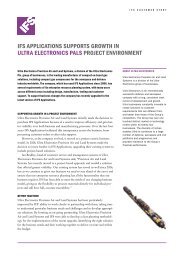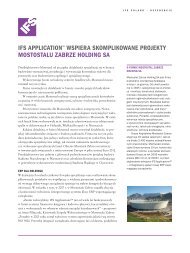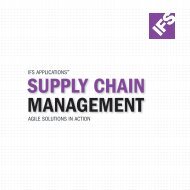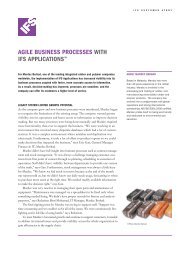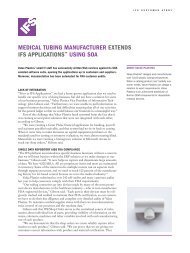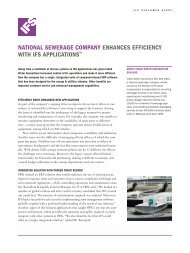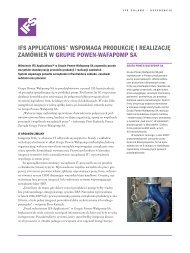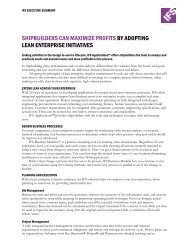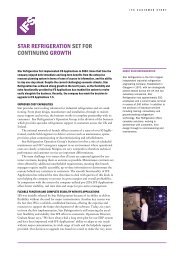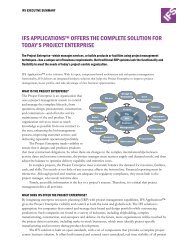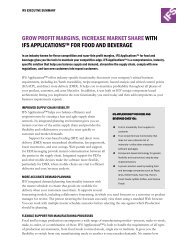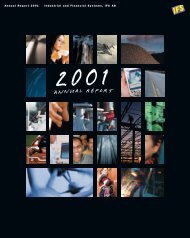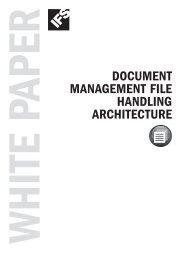Miller Formless - IFS
Miller Formless - IFS
Miller Formless - IFS
You also want an ePaper? Increase the reach of your titles
YUMPU automatically turns print PDFs into web optimized ePapers that Google loves.
I F S C u s t o m e r s t o r y<br />
Technology helps equipment manufacturer<br />
master the costing and pricing processes<br />
Setting the price of goods for sale can be considered either an art or a science.<br />
And accurately tracking the cost of the thousands of component parts that go into<br />
a piece of complex machinery can be some combination of both.<br />
The challenge<br />
Managers at <strong>Miller</strong> <strong>Formless</strong> found that this blend of art and science can benefit<br />
from a little automation. The company was able to leverage costing and pricing<br />
functionality in its existing business software to capture price changes in raw<br />
materials and component parts and update that information in pricing used in<br />
new equipment manufacturing and selling aftermarket parts to customers.<br />
Aftermarket part sales are a small part of <strong>Miller</strong> <strong>Formless</strong>’ revenue, amounting<br />
to about 10 percent of sales, but a big part of what it takes to keep equipment<br />
serviceable in the field for its customers. List price of aftermarket parts<br />
sold directly to <strong>Miller</strong> <strong>Formless</strong> customers—including parts manufactured by<br />
<strong>Miller</strong> and parts purchased and resold for the convenience of their customers—<br />
needed to be tied more directly in with <strong>Miller</strong>’s cost.<br />
About <strong>Miller</strong> <strong>Formless</strong><br />
<strong>Miller</strong> <strong>Formless</strong> Company Inc. of McHenry, Ill.,<br />
U.S.A., manufactures slipform machines,<br />
equipment used to pour concrete curb<br />
and gutter, parapets, barriers, sideways<br />
and pavement. These complex pieces of<br />
machinery are key capital assets for road<br />
building contractors.<br />
The solution<br />
According to <strong>Miller</strong> <strong>Formless</strong> Business Analyst Tony Borkowski, net income as<br />
a percentage of sales at <strong>Miller</strong> <strong>Formless</strong> for 2003, the year before implementing<br />
<strong>IFS</strong> Applications for pricing and costing was 3 percent. The following year, the<br />
company increased its net income as a percentage of sales before adjustments to<br />
10 percent.<br />
“We have maintained double digit percentages in our margin every year since<br />
formalizing our pricing and costing functions.” Borkowski said. “The information<br />
provided has been so useful that we increased our net profit percentage from<br />
year to year even though our net sales were down during the same year to year<br />
comparison.”<br />
But by early 2008, management was only beginning to fully use the solution’s<br />
pricing management capabilities.<br />
“We were not really using the list price functionality in the financials package<br />
to its potential,” Borkowski said. “Our initial pricing strategy was simple and<br />
met our basic needs. Over time we learned more about the pricing module functionality,<br />
and were able to re-think and re-design a more robust, flexible pricing<br />
strategy. Our goal was to allow us to easily review pricing variables and quickly<br />
update price lists instead of looking at individual prices. This is particularly<br />
important on parts that we purchase and resell. We take a lower margin on those<br />
so that we can be competitive and serve as a one-stop-shop for our customers.<br />
So as our cost structure changes on each part, we need to make sure that we<br />
periodically review our cost and update our pricing accordingly given our slim<br />
margin.”
I F S C u s t o m e r s t o r y<br />
En11010-1 Production: <strong>IFS</strong> Corporate Marketing, December 2009.<br />
Automating these price changes turned out to be relatively easy, according to<br />
Borkowski.<br />
Refined pricing processes<br />
“The first thing I did was purge the old price list, which included 10,000 sales<br />
parts. We were pricing these items using 18 different price lists. People in the<br />
company would see all 18 price lists and have to understand which one to use<br />
when. Now we have just two price lists—our base price list and our market<br />
competitive price list, which includes commodity items we sell for the convenience<br />
of our customers,” Borkowski said.<br />
To minimize disruptions, Borkowski exchanged the existing price list for<br />
dynamically sourced price lists driven by <strong>IFS</strong> Applications after hours.<br />
Borkowski said, “Working with Management, it took me about 3 days to<br />
establish the new pricing strategy and figure out how to set it up within <strong>IFS</strong>.<br />
The entire Friday after-hours implementation took less than 3 hours.”<br />
The difference in the way <strong>Miller</strong> <strong>Formless</strong> handled aftermarket part sales<br />
surfaced immediately the following Monday.<br />
“First thing on Monday, I got a call from our parts manager, who had noticed<br />
that the auger flight price was up 65%,” Borkowski said. “I immediately investigated,<br />
and found that our cost had gone up 60% over the last 2 years. We never<br />
increased prices to account for this cost increase… until now. For the last two<br />
years, we had left that money on the table by not utilizing a proper profit margin.<br />
We sell a lot of that part. When it comes to purchased parts like concrete vibrators,<br />
our customer can purchase those parts from the part manufacturer so we<br />
make sure that our price matches or is close to the manufacturer’s retail price.<br />
We want to remain market competitive and want the customer to be satisfied<br />
and buy all of their parts directly from us. We will now be doing regular price<br />
adjustments—up or down—enabled by the new pricing system.”<br />
“Since automating our market competitive parts pricing, we are getting<br />
fewer complaints from customers telling us they can get a part cheaper elsewhere,”<br />
Borkowski said.<br />
When basic materials costs of parts used in the manufacturing process go up,<br />
according to Borkowski, it will be easier to note the price increases and change<br />
them in <strong>Miller</strong> <strong>Formless</strong>’ accounting system.<br />
“When steel goes up as it did a year ago, we need to adjust prices for all of<br />
the manufactured parts,” Borkowski said. “But we are now automating that<br />
process, and will be writing a Crystal Report against that screen to see if we<br />
want to change the price because of price increases from our suppliers. Right<br />
now, we will have to keep an eye on anything that is petroleum-based, like our<br />
hydraulic power hoses.”<br />
Aftermarket service automated as well<br />
<strong>Miller</strong> <strong>Formless</strong> has recently rolled out <strong>IFS</strong> Applications functionality to manage<br />
aftermarket service as well.<br />
“We also just implemented work orders,” Borkowski said. “We are currently<br />
completing only about one or two work orders per week or six to eight<br />
requests a month for service and support on our machines. Previously, we had<br />
been managing all of these service requests on paper. Work orders will help us<br />
track our cost. And our customers’ will notice that as we get busier in aftermarket<br />
service, we have excellent records of what had been done to their piece of<br />
equipment over time, and that can help us troubleshoot things more easily.”<br />
Benefits<br />
• Improved cost management for complex,<br />
highly engineered products.<br />
• Pricing management and automation<br />
on thousands of aftermarket parts.<br />
• Improved aftermarket sales and<br />
service in the manufacturing environment.<br />
“We have maintained double digit<br />
percentages in our margin every year<br />
since formalizing our pricing and<br />
costing functions. The information<br />
provided by these components has<br />
been so useful that we increased<br />
our net profit percentage from year<br />
to year even though our net sales<br />
were down during the same year to<br />
year comparison.”<br />
Tony Borkowski, Business Analyst<br />
<strong>Miller</strong> <strong>Formless</strong><br />
If you need further information, e-mail to info@ifsworld.com, contact your local <strong>IFS</strong> office or visit our web site, www.ifsworld.com



